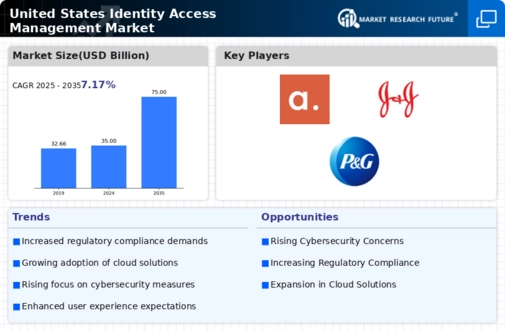Shift Towards Remote Work
The identity access-management market is adapting to the evolving work environment characterized by a significant shift towards remote work. As organizations embrace flexible work arrangements, the need for secure access to corporate resources from various locations has become paramount. In 2025, it is estimated that 30% of the US workforce will be working remotely, necessitating the implementation of identity access-management solutions that provide secure authentication and authorization. This shift is driving the demand for cloud-based identity management systems, which are projected to grow by 15% annually. Consequently, organizations are increasingly recognizing the importance of identity access-management in ensuring secure remote access, thereby enhancing productivity while maintaining security.
Rising Cybersecurity Threats
The identity access-management market is experiencing heightened demand due to the increasing frequency and sophistication of cyber threats. Organizations are compelled to adopt robust identity management solutions to safeguard sensitive data and maintain compliance with regulatory standards. In 2025, it is estimated that cybercrime will cost businesses globally over $10 trillion annually, underscoring the urgency for effective identity access-management strategies. As organizations in the US face potential breaches, the market is projected to grow at a CAGR of 12% from 2025 to 2030. This growth is driven by the need for advanced security measures that can adapt to evolving threats, thereby reinforcing the importance of identity access-management solutions in protecting organizational assets.
Growing Demand for User Experience
The identity access-management market is witnessing a growing emphasis on enhancing user experience. Organizations are recognizing that seamless access to applications and data is crucial for employee satisfaction and productivity. As a result, there is a trend towards implementing identity access-management solutions that offer single sign-on (SSO) capabilities and adaptive authentication methods. In 2025, it is anticipated that 70% of organizations will prioritize user experience in their identity management strategies. This focus on user-centric solutions is likely to drive market growth, with an expected increase of 11% annually. By improving user experience, organizations can foster a more efficient work environment while ensuring robust security measures are in place.
Regulatory Compliance Requirements
The identity access-management market is significantly influenced by the stringent regulatory landscape in the US. Organizations are mandated to comply with various regulations such as HIPAA, GDPR, and CCPA, which necessitate the implementation of effective identity management systems. Non-compliance can result in hefty fines, reaching up to $20 million or 4% of annual global turnover, whichever is higher. As a result, businesses are increasingly investing in identity access-management solutions to ensure adherence to these regulations. The market is expected to expand as organizations prioritize compliance, with a projected growth rate of 10% annually. This trend highlights the critical role of identity access-management in facilitating regulatory compliance and mitigating legal risks.
Integration of Advanced Technologies
The identity access-management market is increasingly integrating advanced technologies such as artificial intelligence (AI) and machine learning (ML) to enhance security and efficiency. These technologies enable organizations to automate identity verification processes, detect anomalies, and respond to potential threats in real-time. In 2025, it is projected that the adoption of AI-driven identity access-management solutions will increase by 20%, as organizations seek to leverage data analytics for improved decision-making. This integration not only streamlines operations but also strengthens security protocols, making identity access-management solutions more effective. As businesses in the US continue to embrace technological advancements, the market is expected to grow, reflecting the critical role of innovation in identity access-management.














Leave a Comment